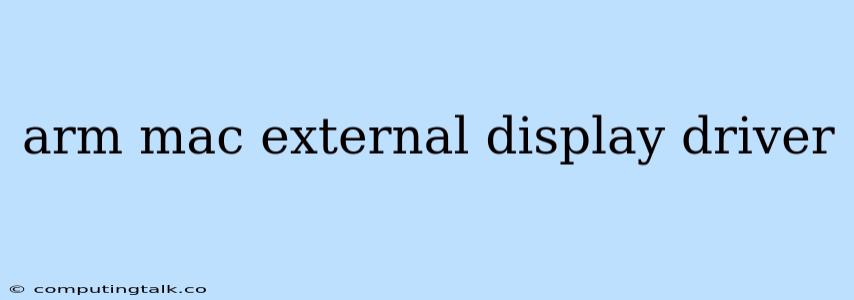Connecting Your External Display to Your ARM-Based Mac: A Guide to Drivers
Connecting an external display to your ARM-based Mac can be a seamless experience, but it's important to understand the driver considerations involved. While many displays work automatically with your Mac, some might require specific drivers for optimal performance and functionality.
Why are Drivers Important?
Drivers act as a bridge between your Mac's operating system and your external display's hardware. They allow the system to understand how to communicate with the display, ensuring proper resolution, refresh rate, color accuracy, and other crucial settings. Without the correct driver, your display might not work at all, or it could operate with limited functionality or display issues.
Do I Need Drivers for My External Display?
Generally, most modern displays with HDMI or DisplayPort connections work seamlessly with ARM-based Macs. These displays usually utilize industry-standard protocols that your Mac can recognize and interpret automatically.
However, there are specific scenarios where a driver might be needed:
- Older displays: If your display is using older connections like VGA or DVI, or it was designed for a different operating system, it may need specific drivers.
- Specialized displays: Some displays designed for specific tasks, such as high-end professional monitors or specialized gaming monitors, may require additional drivers for features like color calibration or advanced refresh rate settings.
- Displays with unique features: If your display has unique features beyond the standard, such as touch screen functionality or integrated speakers, you might need a driver to enable these features.
How to Find and Install Drivers
If you suspect you might need drivers for your display, follow these steps:
- Check the manufacturer's website: The best resource for drivers is the manufacturer's website. Look for a support section or a download area for your specific display model.
- Search for drivers online: You can also search online using the display model name and "macOS" to find available drivers.
- Use Apple Software Update: Sometimes, Apple may release drivers for certain displays through its Software Update system. Check for updates regularly.
Troubleshooting Display Issues
If you're facing issues connecting your external display, here are some troubleshooting tips:
- Verify connection: Ensure your cable is securely connected to both your Mac and the display. Try a different port or cable if possible.
- Check display settings: Open System Settings > Displays and verify that the correct display is selected and the resolution is appropriate.
- Restart your Mac: A simple restart can often resolve connection issues.
- Update your Mac: Ensure you have the latest macOS updates installed.
- Check for driver updates: See if there are any available driver updates for your display.
Conclusion
Connecting an external display to your ARM-based Mac is generally straightforward. However, understanding driver considerations is crucial for optimal performance and functionality. By following the steps outlined above, you can ensure a smooth and enjoyable experience with your external display. Remember to always consult the manufacturer's website for specific instructions and driver downloads for your display model.
